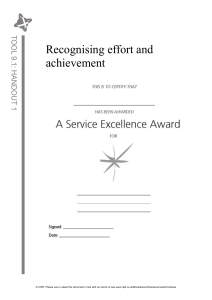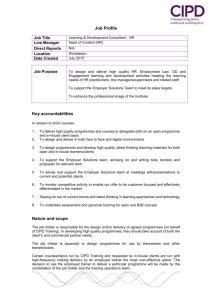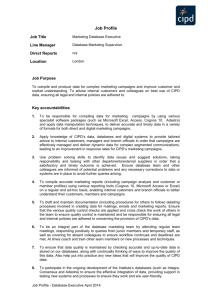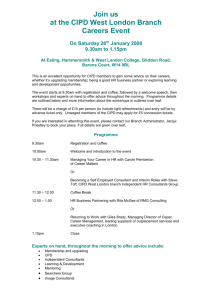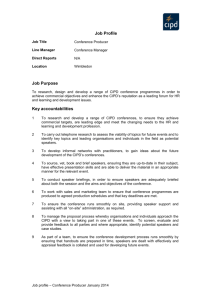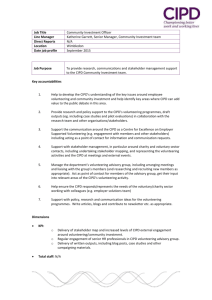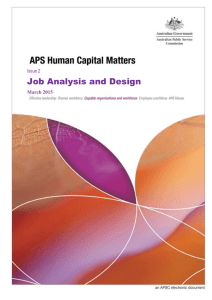Building an excellent reputation
advertisement
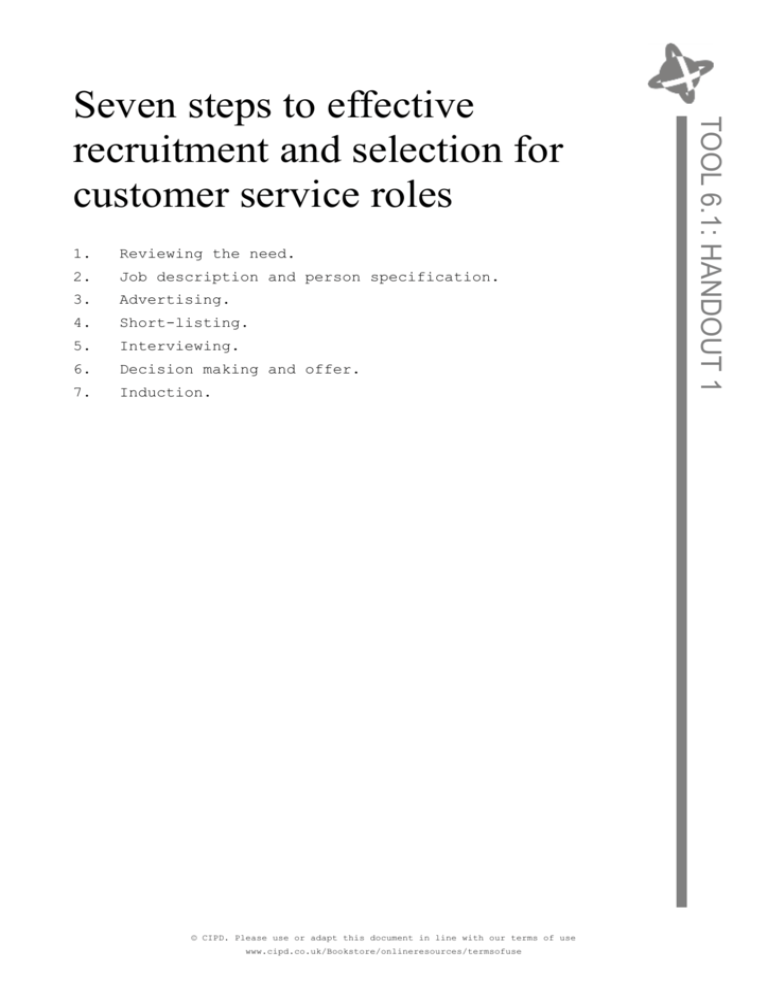
1. Reviewing the need. 2. Job description and person specification. 3. Advertising. 4. Short-listing. 5. Interviewing. 6. Decision making and offer. 7. Induction. © CIPD. Please use or adapt this document in line with our terms of use www.cipd.co.uk/Bookstore/onlineresources/termsofuse TOOL 6.1: HANDOUT 1 Seven steps to effective recruitment and selection for customer service roles TOOL 6.1: HANDOUT 2 Example rating system Candidate responses are measured against the criteria below to assess the extent to which the positive behaviours are displayed. 0–2 2–3 No evidence: Demonstrates no evidence or fails to meet most of the behaviour definition. Less than acceptable: Meets less than half of the behaviour definition. 3–5 Meets the behaviour definition: Demonstrates consistent behaviour. 5–7 More than acceptable: Meets more than the behaviour definition. © CIPD. Please use or adapt this document in line with our terms of use www.cipd.co.uk/Bookstore/onlineresources/termsofuse 7–10 Exceeds most parts of the behaviour: Demonstrates behaviour at high levels exceeding what is expected. Step 1 – Reviewing the need One of the first tasks to undertake when you consider starting a selection process for a customer service post is the posing of the question: ‘Is the role still required?’ Consider the following: • Is the role required? • Is this an opportunity to review the structure of the team/department? • Is it a like-for-like replacement? • Any changes to hours/responsibilities? Step 2 – Reviewing or creating a job description and person specification Job descriptions and person specifications should be created or reviewed prior to each recruitment campaign to ensure that the post is accurately reflected. The job description should focus on responsibilities and not relate simply to specific tasks. The person specification should be sufficiently broad to encourage applications, but not so prescriptive that candidates with all the essential skills and experience will be almost impossible to attract. Skills which can be trained during the day-to-day performance of the post, or by training and development, should be listed ‘desirable’ rather than ‘essential’. © CIPD. Please use or adapt this document in line with our terms of use www.cipd.co.uk/Bookstore/onlineresources/termsofuse as TOOL 6.1: HANDOUT 3 Seven steps to effective recruitment and selection Step 3 – Advertising TOOL 6.1: HANDOUT 3 Bear in mind when advertising the post which recruitment medium best fits the nature, grade, location of the post, the need for diversity representation and previous experience in recruiting similar roles and cost. Remember, the advert is your tool to get the candidates to ‘self-screen’. An effective advert is an opportunity to save time. What do you include? – Clarity on hours, experience you are looking for, essential skills, location and any other criteria that are likely to help individuals to decide to apply or not. Remember the all-important how to apply, who to, in what format and by when. This is the first introduction to the business if you are advertising externally, so it needs to reflect the culture, values and the role. Step 4 – Shortlisting The shortlisting process is undertaken by comparing the CV/application form with the appropriate person specification and recording specific areas of compatibility (or otherwise) using a shortlisting form. Initially, you should shortlist against the essential criteria only. If this results in an unnecessarily high number of candidates, then the desirable criteria should also be used. Remember full notes must be made as to the reason why a candidate is, or is not, called for interview. This is necessary in the event that the organisation is called upon to demonstrate the fairness of its procedures or to justify any decision made by its managers. Step 5 – Interviewing Interviews are not a reliable way of testing for the best candidate. When you have shortlisted candidates for a customer service post, consider what forms of assessment © CIPD. Please use or adapt this document in line with our terms of use www.cipd.co.uk/Bookstore/onlineresources/termsofuse you may use to test the candidates’ suitability for the post in addition to interview. It may be appropriate for example to use assessment centres, where skills are tested with the most successful applicants being invited to return for interview. © CIPD. Please use or adapt this document in line with our terms of use www.cipd.co.uk/Bookstore/onlineresources/termsofuse amongst others testing for: • MS Office Suite – Word, Excel, Access, Outlook and PowerPoint • speed typing • a range of call centre skills • a range of finance department skills • behavioural profiling. Additionally, interview presentations, in-tray exercises and group exercises may be used where these are appropriate to the post. When you do call people to interview, remember the interview questions must be tailored to the competencies that you believe are essential if a person is to perform well in the target job. Most interviews puts contain forward a questions situation where the interviewer asks the applicants and theoretical questions about how they would deal with it. We may get an excellent answer. However, all this is telling us is that the person knows what they should do, not whether they are likely to do it! Similarly, some people may not know the textbook response but may, when faced with a ‘real-life’ situation, respond appropriately with successful results. Best practice is to use behavioural-based interview questions to ask for specific examples of situations which have required the person to demonstrate a particular quality. For example: ‘As you know, in this job it’s really important to be able to quickly build lasting relationships with customers. Tell me about a particularly difficult customer and how you won them round.’ By doing this we are focusing on the actual behaviour demonstrated and by the applicant can follow up © CIPD. Please use or adapt this document in line with our terms of use www.cipd.co.uk/Bookstore/onlineresources/termsofuse the TOOL 6.1: HANDOUT 3 Other assessments for customer service posts could include question with probes such as: ‘What precisely did you do?’ ‘How did he/she respond?’ ‘What was the outcome?’ © CIPD. Please use or adapt this document in line with our terms of use www.cipd.co.uk/Bookstore/onlineresources/termsofuse TOOL 6.1: HANDOUT 3 From the example given by the applicant you can form an objective view of how that person sets about developing and maintaining customer relationships and how sensitively he/she can deal with difficult people. Chances are that the person would tackle things in the same way if the situation arose again. Step 6 – Decision making and offer Even the most structured assessment technique is still open to subjectivity and bias – after all, interviewers are only human and are bound to react to the personality and personal style of the candidate they are assessing. One study estimated that most interviewers make a decision about whether or not to hire a candidate in the first 30 seconds – and then spend the rest of the interview looking for evidence to support their decision. One way of objective keeping as your possible is assessment to as separate accurate the and process of collecting evidence of the candidate’s competence from the process of judging the evidence. To make a candidate following: choice, and complete objectively Essential a scoring compare versus grid scores. desirable for Consider versus each the trainable skills. Giving feedback Candidates may, at any stage of the process, ask you for feedback. It is therefore very important to make comprehensive notes at all stages of the process. Tips for giving feedback Complete the relevant form so you have evidence for each stage of the process. Ask interviewees what they think they did well and what they would do differently. Balance the feedback: what was good and © CIPD. Please use or adapt this document in line with our terms of use www.cipd.co.uk/Bookstore/onlineresources/termsofuse areas for development. Be specific, give examples. Relate the feedback to the competencies and criteria. © CIPD. Please use or adapt this document in line with our terms of use www.cipd.co.uk/Bookstore/onlineresources/termsofuse Discuss and offer suggestions for development. • Thank them for applying. Step 7 – Induction The final step impression. is This an is opportunity often to forgotten really in the make an selection process as people are focused on the appointment. You now have an opportunity to equip the individual to do the job effectively. What is an effective induction? Make sure that you have really thought about scheduling work and activities for the individual to get up to speed. A well-planned induction will impact on the speed that an individual reaches the required performance. Here is an induction checklist Organised Activity Meet and greet on arrival Team members available to be introduced Lunch arranged IT requirements organised Seating arrangements/desk ready Feedback from the interview Discuss job description and responsibilities Meetings arranged with key contacts Outline first quarter objectives Training booked Induction course scheduled HR requirements complete Schedule week-one activities © CIPD. Please use or adapt this document in line with our terms of use www.cipd.co.uk/Bookstore/onlineresources/termsofuse TOOL 6.1: HANDOUT 3 • TOOL 6.1: HANDOUT 4 Assess your recruitment and selection practices When recruiting service-orientated employees, hire for attitude, train for skills. Rate how well you currently recruit and select customer service employees in your area: Strongly disagree Hiring practices 1 We recognise that customer service jobs have the greatest impact on customer satisfaction and take care to hire the best people for those jobs We use a person specification which outlines the specific attributes people need in the role and recruit against these criteria We recruit first for attitude and second for skills Our adverts encourage selfselection in or out of the job We use a range of assessments In addition to interviewing which are appropriate to the job We use behavioural questions as part of the interview process We use clear criteria to evaluate the evidence collected for each candidate We plan and implement a comprehensive induction for each new starter Neither agree nor disagree 2 3 4 Strongly agree 5 Now look at the areas where you have scored the lowest. Develop a plan of action to improve the way recruit and select customer service employees. © CIPD. Please use or adapt this document in line with our terms of use www.cipd.co.uk/Bookstore/onlineresources/termsofuse that you List the internal departments that you receive a service from and those that you give a service to. Internal customers give a service to that we Departments who provide service to us © CIPD. Please use or adapt this document in line with our terms of use www.cipd.co.uk/Bookstore/onlineresources/termsofuse a TOOL 6.2: HANDOUT 1 Who are your customers? TOOL 6.3: HANDOUT 1 Feedback For each department from whom you receive a service and that is present in the room today, provide the following feedback: • What are the strengths of this department? • What can you rely on them to do positively for you? • What are the weaknesses of this department? • In what situations are they NOT reliable? • What one thing above all others should they improve about the service they provide you? © CIPD. Please use or adapt this document in line with our terms of use www.cipd.co.uk/Bookstore/onlineresources/termsofuse • What one key thing will you continue to do as a result of the feedback? • What one key area of weakness do you commit to change? • Who will be responsible? • When will you do this? • How will you inform your internal customers of the changes? © CIPD. Please use or adapt this document in line with our terms of use www.cipd.co.uk/Bookstore/onlineresources/termsofuse TOOL 6.3: HANDOUT 2 Departmental action plan TOOL 6.4: HANDOUT 1 Some characteristics of a highperforming team • Clearly defined and commonly shared objectives. • An understanding of individual roles and responsibilities. • Mutual support and trust. • A co-operative rather than a competitive climate. • An ability to value differences and appreciate conflict. • Open communication lines. • Willingness to subordinate which balances individual goals to group goals. • Leadership direction with support and openness. © CIPD. Please use or adapt this document in line with our terms of use www.cipd.co.uk/Bookstore/onlineresources/termsofuse and control The team iceberg TOOL 6.4: HANDOUT 2 © CIPD. Please use or adapt this document in line with our terms of use www.cipd.co.uk/Bookstore/onlineresources/termsofuse TOOL 6.4: HANDOUT 3 Team assessment checklist 1. What do you understand are the goals/objectives of the team? 2. Describe the role that you play in the team 3. Do you understand everyone else’s role within the team? If not, whose role is not clear? 4. To what degree does your team leader/manager involve you in decision making? 5. What specifically could they do more of? 6. To what extent does your team leader/manager seek your ideas and suggestions? 7. What specifically could they do more of? 8. How effective is this team at airing differences of opinion and dealing with conflict? 9. How well do team members offer you and others support? 10. How well do team members share ideas and input? 11. What else can this team do to deliver an excellent service? © CIPD. Please use or adapt this document in line with our terms of use www.cipd.co.uk/Bookstore/onlineresources/termsofuse Look at the questions below and respond appropriately. • If you feel that your answer is absolutely yes – a rating of 5 should be shown in the appropriate box. • If you feel that your answer is absolutely no – a rating of 1 should be shown in the appropriate box. • If you feel that your answer lies somewhere between these extremes – ie is partial – write 2, 3 or 4, to reflect your view. • If you feel that you cannot answer the question – write a 0 to reflect a don’t know answer. • If you feel that the question does not apply to your business or function, please enter N/A in the box. © CIPD. Please use or adapt this document in line with our terms of use www.cipd.co.uk/Bookstore/onlineresources/termsofuse TOOL 6.5: HANDOUT 1 Does the organisation have a customer focus? TOOL 6.5: HANDOUT 1 A. Vision and values Question A1 A2 A3 A4 A5 A6 A7 Your score Is there an absolute belief, from top to bottom, that business growth and profitability is dependent upon customer satisfaction, retention and loyalty? Are the organisation’s values published in a clear, concise and meaningful way? Were the organisational values, if in place, developed with input from colleagues at all levels? Is the main thread of the organisation’s goals based on the objective of building a customerfocused business? Do all employees have a clear vision on how customers should be treated? Is the organisation’s marketing strategy based upon giving customers a value added service that differentiates you from competitors? Does customer service genuinely sit at the top of the agenda in your business? TOTAL SCORE © CIPD. Please use or adapt this document in line with our terms of use www.cipd.co.uk/Bookstore/onlineresources/termsofuse B. Continual customer research Your score B1 B2 B3 B4 B5 B6 B7 Do we have a clear and well-defined picture of the present and potential customers that the organisation is aiming to serve? Does the organisation regularly conduct research with customers to determine what services they need and want? Do managers at all levels regularly speak to customers, seeking their opinions on our service levels? Does the organisation share customer research with employees at all levels? Does the organisation have an effective system in place for customers to feed back their comments and observations about service levels? Does the organisation use customer research to change systems, procedures and processes? Does the organisation base its products and services on the genuine requirements of customers? TOTAL SCORE © CIPD. Please use or adapt this document in line with our terms of use www.cipd.co.uk/Bookstore/onlineresources/termsofuse TOOL 6.5: HANDOUT 1 Question TOOL 6.5: HANDOUT 1 C. Customer-centric organisation structure Question Your score Does the organisational structure enable C1 you to give customers what they are asking for? Does the organisation structure make it C2 easy for your customers to understand you and do business with you? When the business designs or make changes C3 to the organisational structure, does it consider the needs of customers? C4 Does the business regularly review the structure of the organisation to improve service levels? C5 Does the organisation structure reflect the importance of the internal customer also? C6 Does everyone measurable in the organisation accountability for have customer service? C7 Does the organisation encourage people to recognise the needs of internal as well as external customers? TOTAL SCORE © CIPD. Please use or adapt this document in line with our terms of use www.cipd.co.uk/Bookstore/onlineresources/termsofuse Question Your score D1 D2 D3 D4 D5 D6 D7 Have your service-delivery processes been designed more for the convenience and satisfaction of your customers rather than your own convenience? Are the forms and documents used in your service-delivery processes customer friendly? In designing a service-delivery process does the organisation start by defining the end result for the customer, and then develop the parts of the system needed to bring about that result? Are your service-delivery processes flexible and adaptable to meet the requirements of customers? Are your internal service delivery processes related to customer service simple, flexible, easy to understand and user friendly? Does the organisation compare your service-delivery processes with competitors and revise them accordingly to improve the service? Does the organisation revise its service processes to remove blockages that make it difficult for customers to do business with us? TOTAL SCORE © CIPD. Please use or adapt this document in line with our terms of use www.cipd.co.uk/Bookstore/onlineresources/termsofuse TOOL 6.5: HANDOUT 1 D. Service delivery processes and practices TOOL 6.5: HANDOUT 1 E. Service leadership competencies Question Your score E1 E2 E3 E4 E5 E6 E7 Do all managers demonstrate by their own behaviour, their commitment to achieve the highest levels of customer satisfaction and quality? Is the management style in your organisation highly participative? Is responsibility and authority pushed down to the lowest levels possible? Do managers talk to their teams regularly about customer service? Does the performance management system emphasise the importance of customerfocused behaviours? Does the performance management system reward people who demonstrate customer-focused behaviours? Do managers readily acknowledge service excellence providers? TOTAL SCORE © CIPD. Please use or adapt this document in line with our terms of use www.cipd.co.uk/Bookstore/onlineresources/termsofuse Question F1 F2 F3 F4 F5 F6 F7 Your score Does the organisation have quantified measurements of service efficiency for all key customer contact roles? Does the organisation have quantified measurements of service effectiveness in terms of customer satisfaction? Does the organisations tell employees at all levels the results of customer satisfaction surveys? Does the organisation use customer surveys, either written, telephone or online, to measure service satisfaction? Do we really view our service complaints as an opportunity to improve? Do we make it easy for our customers to complain? If a customer service compliment is received do managers provide direct face-to-face feedback to the employee concerned? TOTAL SCORE © CIPD. Please use or adapt this document in line with our terms of use www.cipd.co.uk/Bookstore/onlineresources/termsofuse F. Meas urem ent of serv ice effi cien cy and cust omer TOOL 6.5: HANDOUT 1 G. Creating the service excellence environment Question G1 G2 G3 G4 G5 G6 G7 Does the organisation operate an effective reward and recognition process for employees who provide service excellence? Does the organisation provide a good environment in the workplace that encourages you to provide service excellence to customers? Do the organisation’s business premises reflect the commitment towards service excellence? Is the telephone technology in the organisation designed for customer and service giver convenience, efficiency and superior service delivery? Do we regularly look at the environment facing our customers and seek to identify improvements? Is the telephone technology in the organisation designed for customer and service giver convenience, efficiency and superior service delivery? Do you have efficient and sufficient work equipment to provide an excellent service to customers? TOTAL SCORE © CIPD. Please use or adapt this document in line with our terms of use www.cipd.co.uk/Bookstore/onlineresources/termsofuse Your score Question H1 H2 H3 H4 H5 H6 H7 Your score Do new employees receive guidance regarding service standards and commitment to excellence prior to starting work? Do our employees receive proper technical – ie product, systems, equipment – training to ensure that they are equipped to service customers? Do employees receive sufficient service skills training? Does the organisation have service standards to which new employees are trained? When the business changes a service process, do managers adequately communicate and train employees? Does the organisation invest sufficiently in service skills training? Does the organisation provide effective routes for career progression? TOTAL © CIPD. Please use or adapt this document in line with our terms of use www.cipd.co.uk/Bookstore/onlineresources/termsofuse TOOL 6.5: HANDOUT 1 H Training and development of service skills TOOL 6.5: HANDOUT 2 Does your business have a customer focus? Score sheet Calculate the average scores for each category. Transfer the scores to the grids below. Then compare the scores. Then find the average score for each category for each department. © CIPD. Please use or adapt this document in line with our terms of use www.cipd.co.uk/Bookstore/onlineresources/termsofuse Average scores © CIPD. Please use or adapt this document in line with our terms of use www.cipd.co.uk/Bookstore/onlineresources/termsofuse
